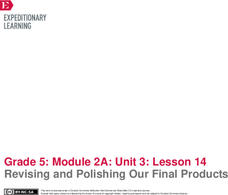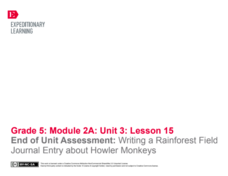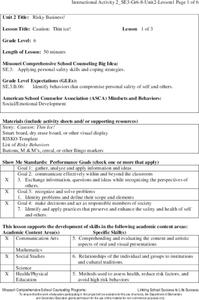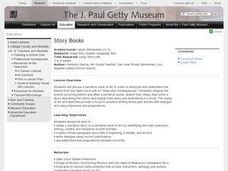EngageNY
Revising and Polishing Our Final Products
One, two, three go! Scholars work independently to finalize the three components of their final task. They complete a science journal entry, scientific text box, and scientific drawing. While working, learners sign up for an...
EngageNY
End of Unit Assessment: Writing a Rainforest Field Journal Entry about Howler Monkeys
Give me more details. Scholars complete an end of unit assessment by creating an information text box to go with their field journal entries about howler monkeys. Learners use the class time to work independently.
Crafting Freedom
George Moses Horton: Slavery from a Poet's Perspective
Pupils have the unique opportunity to learn about the institution of slavery by reading first-hand experiences as described by George Moses Horton, the first slave to publish anti-slavery poetry.
Lakeshore Learning
Report Card Comments
Every teacher should keep this document handy when it comes time to writing report cards. It includes a plethora of ideas to look to for inspiration when commenting on student strengths and areas of...
PBS
Stories of Arrival
While every family's immigration story is unique, patterns emerge when looking at individual narratives. Using clips from the PBS video series, "Latino Americans," learners look at commonalities among immigrant experiences. A chart helps...
EngageNY
Analyzing How Shakespeare’s Play Draws upon Greek Mythology: Part 3
How do the narrative and play versions of the myth "Pyramus and Thisbe" affect meaning? Scholars reread Act 5, Scene 1 from Shakespeare's A Midsummer Night's Dream and compare its structure to "Pyramus and Thisbe." Next, they use a...
Missouri Department of Elementary
Caution: Thin Ice!
Sixth graders listen to a story titled "Thin Ice!" then partake in a whole-class discussion asking and answering questions about what was read. Scholars brainstorm risky behaviors in preparation for a game of RISKO—a game similar to...
DocsTeach
Examining Where Rosa Parks Sat
When Rosa Parks took her seat on a public bus to protest segregation, she also took her place in history. Learners examine a clue from this story—a diagram of the bus—to see if they can figure out the pivotal role of this...
Curated OER
The Stories Behind the Masterpieces
Young scholars examine Rembrandt's self-portraits and discuss important events in his life. They also examine "Aristotle with the Bust of Homer" and try to identify with the person in the paining, predicting what his life might have been...
Curated OER
Chronology: Visual Timeline
Students begin their timelines with the first narrative that they read and add to the timeline as they go. They create a list of history topics and themes that are important to the story. Students add these as sub-headings to the...
Curated OER
Dear Diary
In this narrative learning exercise, students compose a diary entry that includes different facets of writing. Students then respond to different narratives in the class by answering 11 different questions.
Curated OER
Story Books
Learners discuss a narrative work of art, then write stories describing the action and publish their stories and illustrations in books.
Curated OER
Telling Stories: Witness to a Brawl
Students examine Georges de la Tour's, The Musicians' Brawl and discuss the narrative elements of the painting. They write an newspaper article of what they believe they are witnessing in the painting.
Curated OER
Dialogue Tags/ Synonyms for Said
Sixth graders analyze dialogue tags. In this synonyms lesson students work in groups analyzing a personal narrative. They enter the words onto a classroom chart as well as their notes or journal. The students replace tags with more...
Curated OER
Point of View
Fifth graders identify first and third person points of view in literature. In this point of view lesson students compare the point of view in different pieces of literature, some telling the same story. Students write a first-person...
Curated OER
Adding Details Using Rainbow Writing
Students use the rainbow technique to add details to their writing. In this writing lesson plan, students practice showing not telling to add visualization to their writing.
Other popular searches
- Narrative Writing
- Narrative Writing Prompts
- Narrative Writing Ideas
- Personal Narrative Writing
- Narrative Writing Grade 3
- Narrative Writing Worksheets
- Cinderella Narrative Writing
- Teaching Narrative Writing
- Narrative Essay Writing
- 3rd Grade Narrative Writing
- Fictional Narrative Writing
- Narrative Writing Organizers

















